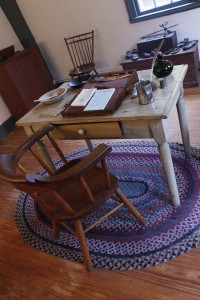Would you like to be an actor in your own crazy play, a play you can make up any minute as you go along? That’s basically what telling your story in first person is.
If your narrator is a character in your story, his point of view does come with a couple of limitations though: What your narrator knows, what he sees, what he feels all have to go through the filter of your character’s personality. You can’t switch perspectives and fly from location to location as easily as a neutral narrator, you can’t stay as invisible as a neutral narrator… in short, you lack superpowers!
This post aims to offer a bunch of solutions for one problem in particular: How do you describe somebody when you can’t see him because you are inside of him, looking out, and you don’t even have a reason to describe him? How can you tell your reader what your character looks like through his own eyes?
If your hero suddenly drops a lot of info about her physique without any rhyme or reason, it can easily look like a bad clutter of information, a huge footprint of the author. And because I know flaws like these can easily be overlooked, you can find a free goodie below the post to help you discover problems with your perspective and any other imaginable part of your story (it uses test questions).
Sure, if you are writing your story in first person you could just say: “Hi, I’m Bob, I’m 5’ 7’’, have a greasy ponytail, a porn moustache and mustard stains on my Mickey Mouse t-shirt.” (Wanna meet him, anybody?) That would be very obvious though and also quite boring. Instead, it’s much more rewarding to smuggle information through to your reader carefully interwoven with your story; take her by the hand and gently guide her along into your illusion!
For quick reference, I have compiled the most creative and exciting ways to show what your narrating character looks like:
- Good Old Mirrors
That’s the obvious one, and it might be a bit overused. The character could view herself in the bathroom mirror at home or at a restaurant, but there are also many other mirrors in our lives: Think of the rearview mirror of a car, your make-up kit or even a house of mirrors at an amusement park.
- Any Reflecting Surface
Likewise, any reflective surface can be used for mirroring fun: Take the window of a train compartment, a shop window, any smooth water surface (whether it’s a lake, a swimming pool or your mom’s bathtub), metal surfaces like pots, sugar boxes of silver, door handles of brass, or any smooth industrially made metal plate like a metal table in a restaurant kitchen or a morgue slab (a pretty combination, right…?).
Some of these surfaces do reflect better than others – so make sure you only go as detailed in your descriptions as is realistic.
- Any Portrayal of Your Character
Now we become less industrial and more human. Think of any photo your character could have hanging on his wall or standing on his nightstand, portraying himself. Why not let him flip through a family album?
The most likely photos would be from his childhood days or with friends or family; likewise on special days, for example in full-on wedding gear or at his graduation ceremony in robe and cap; a proud mugshot, whatever… Family photos on office desks are very popular with screenwriters looking to show off their characters’ family ties.
But your portrayals don’t have to come by lens, they could also come by brush. Yes, some people let themselves paint and hang it on their living room wall. Others receive paintings as gifts from relatives or from their poker club. And some will find their paintings even in galleries or over their cousin’s toilet; in fiction, the possibilities are endless, just play with your ideas and spice them up!
How about a scene in which a sidewalk artist paints a portrait of your protagonist, leaving ample room for conversation about his best physical traits and shortcomings?
Also, it doesn’t have to be precisely a painting, maybe it’s a piece of embroidery or a plaster-cast of his face or… you get the idea.
- People Tell Him What He Looks Like
Lean back; you, the author, got nothing to do with it: Just let your characters describe him! The range goes from simple comments that he looks pretty or ugly to detailed remarks about his appearance.
Make sure to always give the speaker a really good reason for his remarks. For example, imagine a scene on the beach and somebody telling your narrator: “Get some sunblock, dude! Guys with your complexion look like crabs after five minutes.” What do we know about the character’s appearance now?
Imagine somebody telling a blonde joke and immediately apologizing to your narrator (just for the heck of it?). What do we know about her?
- Putting Together the Details
You can sprinkle clues of what your character looks like throughout your story like raisins in a plum cake and let the reader combine all of the details.
For example, Martin needs to fold up like an accordion on airplane and theatre seats, which suggests that he is tall. Charlie strokes over his bald head frequently, which means he doesn’t need a hairdresser anymore.
- Abstract Solutions
Now we get to the far out solutions. Not as far out as a giant bunny rabbit named James suddenly appearing to reveal to your character that she is beautiful – but still, if not done carefully, these tricks can leave a stale aftertaste in your audience’s mouth.
Here are the candidates:
Number one is the old author’s favorite for tying up impossible endings: It was just a dream! So your figure might for example see himself floating from above while sleeping. Now he has an opportunity to describe what he looks like.
Number two is a near death experience and would definitely involve floating from above, if you can believe the cliché. People who were clinically dead for some time have described this experience as “hovering in a white tunnel.” It has the side effect of letting your character take a good, hard look at himself.
Number three is indeed the introduction of an abstract figure, and it doesn’t have to be the giant rabbit. Take the grim reaper, angels or the devil, showing your character her body from outside. The experience could be induced by drugs, trauma or extreme sleep deprivation. As you can imagine, this is no everyday solution for your story…
- Inner Monologue
Finally, let’s also mention that if nothing else works, you can always fall back on inner monologue. Again, make sure there is plenty of motivation for your narrator to judge or describe himself: Insecurity, vanity, or whatever else it may be – and I’m sure you can find some positive reasons as well… as soon as she is talking about her feelings, you can easily bridge the gap to her appearance.
So there you have it, a lot of options to choose from for this little problem. Now over to you: What’s your favorite way of letting your readers know what your characters look like, even if you don’t tell the story through their eyes? How do you tackle this challenge? Let us know in the comments!
 About the author: Alex Limberg is the author of Ride the Pen, a creative writing blog dissecting famous writers (works, not bodies); his blog includes detailed writing prompts. Train your idea muscles with a 6-part writing exercise in his free e-book (download here) about ‘44 Key Questions’ to test your story. Shakespeare is jealous. Alex has worked as a copywriter in a Hamburg advertising agency and with camera and lighting in the movie business.
About the author: Alex Limberg is the author of Ride the Pen, a creative writing blog dissecting famous writers (works, not bodies); his blog includes detailed writing prompts. Train your idea muscles with a 6-part writing exercise in his free e-book (download here) about ‘44 Key Questions’ to test your story. Shakespeare is jealous. Alex has worked as a copywriter in a Hamburg advertising agency and with camera and lighting in the movie business.
Image: MorgueFile: The Brass Glass

Good tips. I always sound cheesy when I’m writing 1st pov – which is why I generally write in 3rd :)
That’s another way to avoid that problem altogether… :)
Btw, the link above to the download is fixed and works now.
Elizabeth – Thanks for hosting Alex.
Alex – You’ve definitely nailed one of the challenges of writing in 1st person. But as you say, there are ways to show credibly what a character looks like even if one writes in 1st person. Thanks for your ideas.
Yes, there are a couple more challenges when writing in first person. The problem I talk about here is relatively easy to resolve with a little idea.
Glad you like it.
You’d have to be really subtle to do it right. I think first person is challenging anyway.
Being subtle is key. First person has its own set of problems, just like third person, IMO.
Or how about second person? I will have to try that one time…
I had never considered so many ways for one to look at themselves. Great tips.
Thank you very much, Mason!
I like the little tips. You can say a lot about a character’s looks through their actions.
You can, definitely.
Oh, I liked the idea of flipping through photographs, I’d never thought of that before. Great advice, thanks!
Photographs are awesome! ;)
On twitter, somebody had an additional suggestion: Selfies and avatars. Cutting-edge 21st century stuff…
I use mirrors for my characters to help describe them to the reader. I know it’s a bit that is used too often, so I add something to the scene like playful banter. Like so:
She took a moment to look into a small oval mirror on the wall. Time to let off a little steam.
Leaning her weight to one side of her hips, she ran her fingers through her shoulder length blond hair, puckered her lips and put on a quick layer of lipstick. Debbie knew she had hubby’s attention. She looked at Bob in the reflection and caught him stealing a glance.
So busted.
Hey Stephen, it’s great you are letting us take a glimpse at your writing room.
So you make sure the look in the mirror is justified and the description is very much part of the scene; well played.
These are great tips! I tend to write in close first person, and it can definitely be difficult to describe my protagonists — especially without using the mirror trick, which is definitely done a LOT.
Yes, the mirror trick is getting old.
Rock on, Caryn!